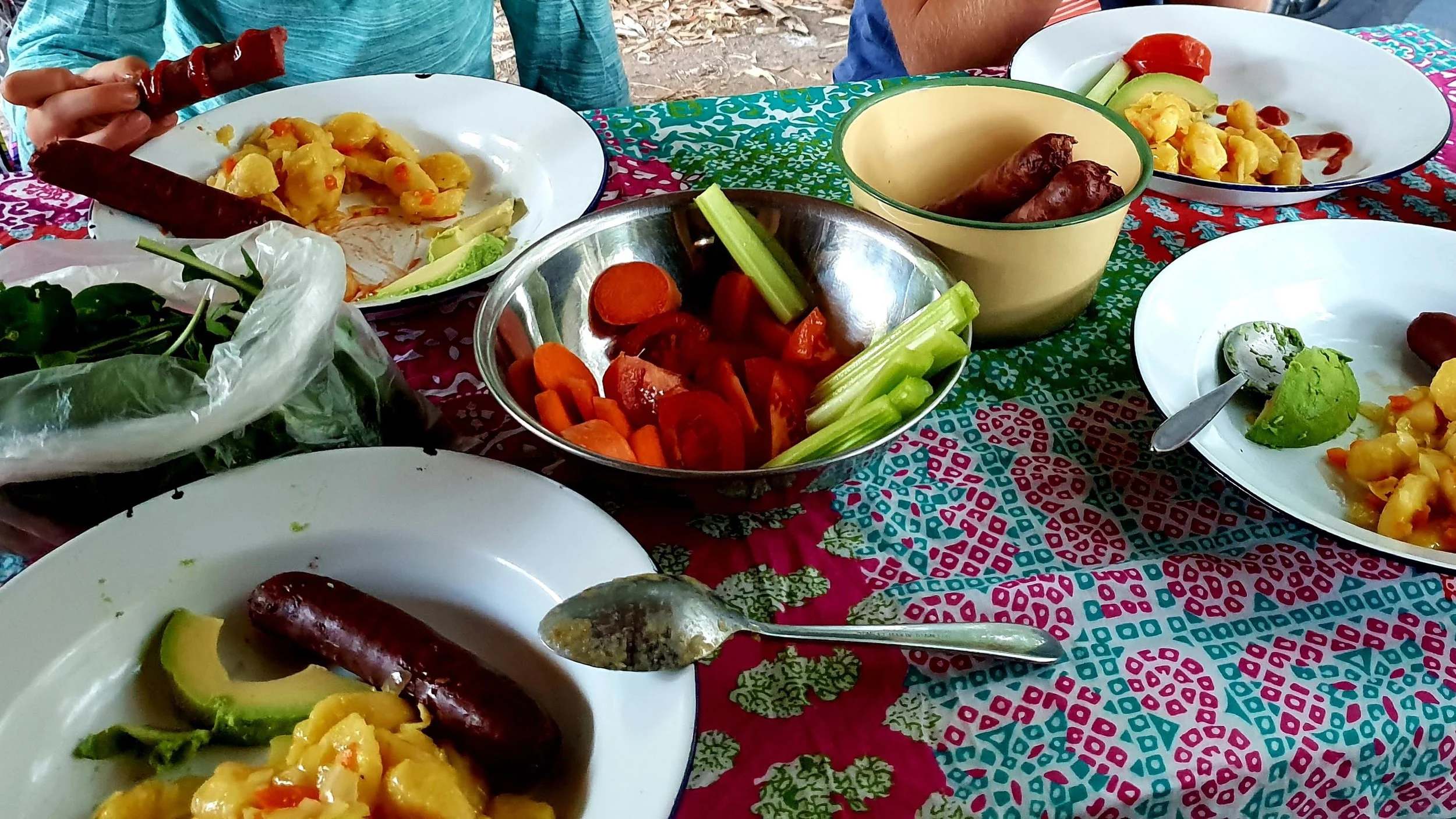7 tips to get your kids to eat more vegetables - PART TWO
Make a rainbow
Does your child have a favourite colour? Maybe they’d like to make soup or a smoothie in that colour? I’ve worked with kids who will not eat any green vegetables, cooked or raw, but who will happily eat “green” soup every day. This “green soup” was packed with goodness (homemade broth, broccoli, spinach, potatoes, onions, peas, zucchini and sometimes even lettuce!) and this child’s parents felt comfortable about the job they were doing. (This child eventually grew to eat vegetables). I’ve worked with other children who were picky with vegetables, but would happily have a green, pink or purple smoothie. [Note that a “smoothie” for me is not a store-bought drink containing ice-cream or lots of sugar, but rather a home made affair containing any or all of the following; milk (or an alternative), oats, yoghurt, blueberries, açai, raspberries, bananas, collagen powder, spinach, spirulina, turmeric, mango and anything else I have that I think might work. Try and keep some amount of “chunkiness” in the smoothie, and encourage chewing!]
Be cautious with juices. There is debate about whether juice is a serving of vegetables or not. Whilst a freshly made juice can contain many “phytonutrients” (simply plant nutrients - a good thing), they also contain little to no fibre. Fibre is what binds the sugars in fruits. Ideally we chew the food, the fibre is broken down and the sugars are slowly released into our bloodstream. The broken-down fibre is then used to feed the bacteria in our guts. This means that blood sugars remain stable, we stay full for a longer time, our guts are healthier and the fibre can then go on to remove “waste” from the body. WIthout the fibre, it’s really just a sugary drink.
Make a platter of rainbow coloured food. You can even do it in the shape of a rainbow! Plenty of colours without the artificial colourings.
Normalise a colourful meal. A risotto can have green peas, orange carrots, red capsicum and brown mushrooms. A stir-fry could have orange carrots, yellow capsicum, green sweet peas, white bean shoots. A salad could have green cucumber, orange capsicum or tomatoes, green lettuce, pale green celery and dark green roquette (it is admittedly a rare child who will eat roquette, but they do exist!). A sandwich or burger could have red tomato, green lettuce, green avocado, pink beetroot and orange carrot. This is also pretty useful when kids are learning their colours.
Ask your kids to pick a colour that is missing from the meal, then let them suggest which vegetable you could add. One of my own children started eating more vegetables using this idea. She loved being a part of the cooking, and having a choice in what the family was eating.
Hide the vegetables
This is an oldie but a goodie! I never believe that children should be lied to when it comes to food. I think we should be allowing kids to get to know their tastebuds and their food by being exposed to a wide variety of flavours, textures and culinary experiences. In the meantime, why not add a few extra veggies to your meals. If your child asks what is in the meal, get them to guess, and be honest! My bolognese sauce, for example, always has carrots, tomatoes, onions, beetroot, celery and garlic. I’ll often add something green (kale, lettuce, basil, parsley, etc), as well as anything else that needs using up (mushrooms, zucchini, red capsicum etc). In the early days you can blend the food so the veggies are truly “hidden”, but as it becomes more normal for your family, increase the size of the vegetables.
To a soup, add whatever you’ve got, and then blend! Peas are nice and sweet to add to a meal, but only add them at the very end so they stay sweet and bright green.
If I’m making a chicken curry, I’ll always add pumpkin and cook it for a while so that the pumpkin melts into the sauce and is barely detectable.
Another popular idea is to steam or otherwise cook your vegetables in batches, freeze portions in an ice tray and store in the freezer. You can then add some extra cubes of veggies to a meal.
Add sweet potato, zucchini, carrots, corn, pumpkin, spinach, capsicum, or any other vegetables, to pancakes, muffins and slices. There are numerous recipes available online to give you ideas.
Think about parasites!
YUCK! This is truly icky, I know, but intestinal parasites, such as threadworm, can affect feeding habits. If you suspect something, then get it checked out and treated! (A Maternal and child health nurse, a pharmacist, a GP or your healthcare professional can assist with diagnosis and treatment)
Gut bacterial imbalance can also affect food preferences. There are some scientists researching theories that show how our gut bacteria can influence our tastebuds, driving us to desire the foods that keep the bacteria thriving! The bacteria that love sugar can be hard to shift! I have certainly seen children whose food preferences have changed after an illness that has been treated with antibiotics. Most health practitioners now agree that our gut bacteria influence our health, but how to manage and treat this is still under debate. Rebalancing gut bacteria can be tricky for children. Again, if you suspect something then seek out the help of a trained health professional.
Food intolerances
In my practice I find that the pickiest of eaters can often have one or many food intolerances. If they have eaten something that makes them feel bloated, full, lethargic, or just plain “yucky”, then they can lose their appetite and start to refuse food, and vegetables are often the first food group to be rejected. The child may have learnt that food makes them uncomfortable, and so choose to be picky about eating to protect their little bodies from this discomfort. Elimination diets can be helpful in working out which foods are causing problems, but can be difficult to do. Once again, if you suspect this, then do check with your GP or favourite healthcare professional to help you work out how to proceed.
Learn to listen to your child
Babies and children tend to be very good at listening to what their bodies need (within reason and perhaps depending on their gut bacteria! ). Some studies have shown that children will pick a wide variety of food, when given the option to choose food for themselves. Perhaps they will choose the sweet foods initially, but over time will take in enough variety to keep their bodies healthy.
Is your child actually exhausted at dinner time, and needs to have their main meal at lunchtime, when they can chew better and eat more?
Are you serving too big a portion of food and expecting your child to eat too much?
If you have any concerns around food choices, food portions or the growth rate of your child, then again...go and see your maternal child health nurse, your GP or your healthcare professional.
Have a picnic at every meal
I worked with a family who had a regular meal that they called “a little bit of everything”. They would have “a little bit of everything” for dinner at least once a week. This could include anything they had on hand; a bit of toast with hummus, carrot sticks, cucumber sticks, chick peas and a cold sausage! Or perhaps steak, broccolini, garlic gnocchi and oranges. How about cheese and crackers, peanut butter and celery, tomatoes and lettuce wraps with tuna/avocado. It can be done with platters on the table and the kids choose, or plate them up a bunch of their favourite things. ‘A little bit of everything” works for breakfast, lunch, dinner or snacks!
Try organic, biodynamic or pesticide-free produce
Sometimes children can be picky about vegetables because they actually taste yucky! Some theorise that it is the chemicals/pesticides on regular vegetables that taste bitter and deter children from eating them. Others believe that organic produce has more flavour (another area of debate in the food industry!)
Supermarket food is wonderful. We are so lucky to have such an amazing choice of foods available to us that are cheap and easily accessible. But sometimes supermarket food is highly processed, full of sugar, salt and fat, and contains “fresh” produce that is far from fresh (ie apples that have been in cold storage for months before being put on the shelf and sold). Organic food can be expensive when bought from the supermarket, and isn’t always fresh either. It can also come wrapped in plastic, which is another whole debate in itself!
Order a veggie box from a local farm and have it delivered weekly, or buy from a farmer’s market. There are some local farms that are not certified organic, but can be “pesticide free”. The produce can be truly delicious and you’ll remember what food tasted like when you were a kid. In my own family we buy organic and biodynamic produce and have done for many years now. A few years ago our local farmer went on holidays and so I bought produce from the supermarket for the first time in a long time. I roasted some beetroot (a regular thing in my home...my kids will eat beetroot in many different ways) and the kids both complained that the beetroot was awful and they wouldn’t eat it. I tried it and felt inclined to agree with them! It just lacked flavour, texture and deliciousness. If you do try going organic for a while, just know that it is sometimes obviously tastier initially, but for other people it is not noticeable until you go back to eating regular produce. Then the difference can become more obvious.
Grow some seedlings in your backyard. Even if it is just lettuce, spinach or herbs in a pot, it doesn’t take much effort to get something growing.
Remember that none of these things will work for everyone! Our children and families are all very unique and we need to work with each child individually, as well as each family as a whole.
Do seek help from a trained professional if you are worried about any aspect of your child’s health or eating habit, or if you are finding this whole parenting gig a challenge. There is a lot of support available, so ask your maternal and child health nurse, your GP, your pharmacist or another qualified health professional.
Take your time, be persistent and calm and most of all, try and have some fun growing, preparing and cooking food and then eating together.



